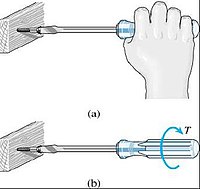
Photo from wikipedia
Virtual reality (VR) offers extraordinary opportunities in user behavior research to study and observe how people interact in immersive 3D environments. A major challenge of designing these 3D experiences and… Click to show full abstract
Virtual reality (VR) offers extraordinary opportunities in user behavior research to study and observe how people interact in immersive 3D environments. A major challenge of designing these 3D experiences and user tasks, however, lies in bridging the inter-relational gaps of perception between the designer, the user, and the 3D scene. Paul Dourish identified three gaps of perception: ontology between the scene representation and the user and designer interpretation, intersubjectivity of task communication between designer and user, and intentionality between the user's intentions and designer's interpretations. We present the GUsT-3D framework for designing Guided User Tasks in embodied VR experiences, i.e., tasks that require the user to carry out a series of interactions guided by the constraints of the 3D scene. GUsT-3D is implemented as a set of tools that support a 4-step workflow to (1) annotate entities in the scene with navigation and interaction possibilities, (2) define user tasks with interactive and timing constraints, (3) manage interactions, task validation, and user logging in real-time, and (4) conduct post-scenario analysis through spatio-temporal queries using ontology definitions. To illustrate the diverse possibilities enabled by our framework, we present two case studies with an indoor scene and an outdoor scene, and conducted a formative evaluation involving six expert interviews to assess the framework and the implemented workflow. Analysis of the responses show that the GUsT-3D framework fits well into a designer's creative process, providing a necessary workflow to create, manage, and understand VR embodied experiences.
Journal Title: Proceedings of the ACM on Human-Computer Interaction
Year Published: 2022
Link to full text (if available)
Share on Social Media: Sign Up to like & get
recommendations!